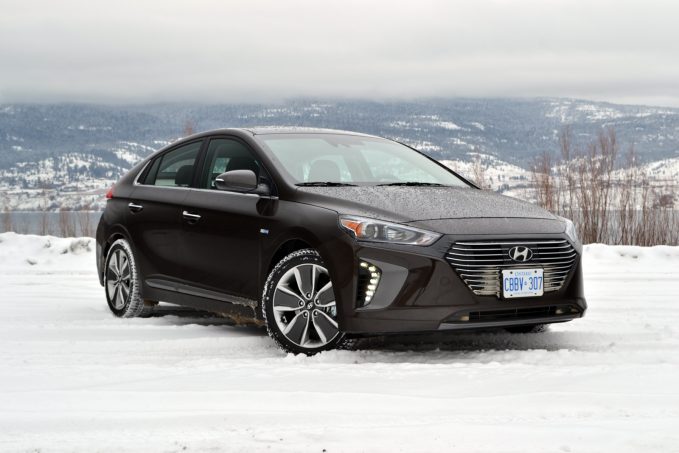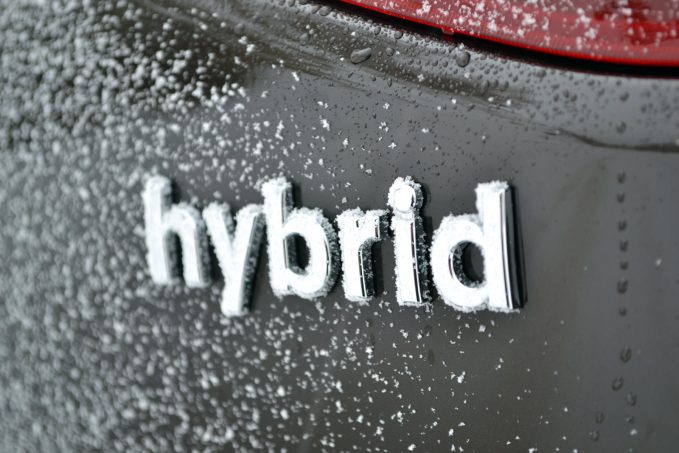As good as it is, it’s tough to describe the 2017 Hyundai Ioniq Hybrid as anything but ill-timed.
As an alternative fuel vehicle, the Ioniq is going up against gas prices that remain at historic lows. Convincing consumers to make the move away from fossil fuels was tough when the national average price for a gallon of gas in the U.S. was a whopping $3.60 back in 2012; it’s hard to imagine that reality changing with prices hovering around $2.30/gallon these days.
That this Hyundai is a compact car only makes matters worse for the Ioniq, as the popularity of crossovers continues to climb. That puts it at a major disadvantage compared to its fuel-sipping sibling, the Kia Niro, which features the people-moving proportions that consumers crave.
A Dedicated Hybrid
To overcome those sizable-though-surmountable odds, the Hyundai Ioniq Hybrid has a few key qualities working in its favor. For starters, it’s built on a dedicated platform developed solely to serve as the basis for electrified rides. It’s part of Hyundai’s three-pronged approach to taking on the likes of Toyota, and includes both conventional and plug-in hybrid versions of the Ioniq, plus a pure-electric model. The platform also underpins the Kia Niro, and has been optimized for maximum efficiency.
Which brings us to the body style. While a crossover would no doubt have more mass appeal than a small sedan, it would also be less efficient. As such, the decision was made to build the Ioniq as a small sedan — and one that’s designed to eke out as much efficiency as possible. But more on that later. While not quite as quirky-looking as the Toyota Prius, the Ioniq definitely stands out as different. That, of course, was done with a purpose, with the very shape of the Ioniq cleverly crafted to improve airflow. And it worked. With a drag coefficient of 0.24, the Ioniq slips through the air like a Tesla Model S, offering little in the way of resistance.
ALSO SEE: 2017 Kia Niro Review
The Ioniq may share its drag coefficient with the Model S, but it’s smaller than that all-electric ride — significantly smaller. Riding on a wheelbase that measures 106.3 inches (2,700 millimeters) and stretching 176 inches (4,470 mm) from tip to tail, the Ioniq is more similarly sized to the Prius or Chevrolet Cruze. Likewise, it is equally low, measuring just 57.1 inches (1,450 mm) at its tallest point.
Those diminutive dimensions impact interior space in different ways depending on where you look. The front seats, for instance, pack plenty of room, and feel no less spacious than those of a much larger car. Slide into the rear seats, however, and space shrinks significantly. Leg- and headroom in the back is on par with the others in the segment, including the Prius, though that doesn’t mean either measure is particularly generous.
Open the car’s massive rear hatch, however, and the Hyundai Ioniq Hybrid again ranks near the top of the pack. With its battery positioned beneath the second row of seats, cargo room stands at an impressive 26.5 cu-ft (750 liters). That mark is second in the segment only to the Prius, and exceeds the likes of the hatchback versions of the Cruze and Honda Civic. And like those cars, the Ioniq also benefits from a second row of seats that can be folded completely flat to accommodate larger items. The space to do so may not stand up very tall, but that’s, again, a product of the car’s odd shape.

Non-Hybrid Drive
The Ioniq Hybrid may not necessarily look like a conventional compact car, but it certainly feels like one out on the road. Like the Niro, this gas-electric version gets its power from a drivetrain that includes a small electric motor wedged between a four-cylinder engine and a six-speed automatic transmission. The engine, a 1.6-liter unit, combines with the electric motor to send a total of 139 horsepower and 195 pound-feet of torque to the front wheels through a newly developed dual-clutch gearbox. And it’s that transmission that perhaps plays the biggest role in making Ioniq’s drive feel more conventional, with the familiar feel of actual gear changes welcome from behind the wheel.
With the added weight of the hybrid system, the Ioniq Hybrid drives an awful lot like a heavier and less peppy Hyundai Elantra sedan. Throttle response can seem at times like the gas pedal isn’t connected to the powertrain, particularly when switching between the two power sources, and the silence of electric acceleration are dead giveaways of the Ioniq’s hybrid ways, but it does an impressive job of convincing you otherwise in most situations. The same can’t be said about the Prius, which drives like, well, a Prius, and is mostly uninspiring.
ALSO SEE: 2017 Toyota Prius Prime Review
There should be little confusion over what the Ioniq Hybrid is — a fuel-sipping compromise between a conventional gas car and an electric one — though it does find a way to provide some level of liveliness when out and about. The steering is fairly nimble, though not overly communicative, while the chassis and suspension are taut enough to verge on sporty while doing a nice job of soaking up bumps without passing them on inside the cabin. Overall, the ride manages to be engaging without coming across as fun — an added bonus when it’s meant to be all about economy.
And on that front, the Ioniq Hybrid does well. Base models aimed at maximum efficiency are rated at 58 mpg (4.1 L/100 km) combined, while the remaining trims come in at 54 mpg (4.4 L/100 km). Those numbers put Hyundai’s first dedicated hybrid ahead of the standard-bearing Toyota Prius, which manages a combined 52 mpg (4.5 L/100 km) in all but its most efficient model. That U.S.-exclusive version, dubbed, the Prius Eco, is good for a combined 56 mpg (4.2 L/100 km). But best of all, you don’t have to hypermile the Ioniq Hybrid to get the most from the car’s hybrid powertrain. While our sample size was small, we managed better than 49 mpg (4.8 L/100 km) over 80 miles (130 kilometers) or so of driving through some pretty treacherous conditions with winter tires strapped to our fully loaded Limited trim tester.

Priced to Sell
That impressive efficiency is only matched by the Ioniq Hybrid’s ambitious price point. Stroll into your local Hyundai dealership and you can drive away with a brand new Ioniq Hybrid for just $23,035 including destination (base models are estimated to start at $24,000 in Canada). Head over to the Toyota store and an equivalent Prius will set you back $25,085 ($28,880 in Canada). Step up to a top-of-the-line Limited model and you can expect to pay $28,335 (estimated at $31,000 in Canada). A loaded Prius Touring, meanwhile, will fetch $28,985 ($32,115 in Canada).
For that base price, you get a reasonably equipped car that features a seven-inch touchscreen infotainment system with Android Auto and Apple CarPlay smartphone integration, as well as keyless entry, push-button start, cruise control, and dual-zone automatic climate control, among others.
ALSO SEE: 2017 Hyundai Ioniq Electric Review
Fully loaded cars, meanwhile, get the full gambit of features, including leather seats, wireless phone charging, adaptive cruise control and autonomous emergency braking with pedestrian detection. A so-called Technology package takes it step further and adds a larger eight-inch touchscreen with native navigation, an eight-speaker stereo, and a seven-inch screen in the gauge cluster.
The Verdict: 2017 Hyundai Ioniq Hybrid Review
Despite everything the Hyundai Ioniq Hybrid does right, it’s not perfect. The regenerative brakes felt slightly rubbery, and a little more engine noise than necessary permeated the cabin. Likewise, there were some unwelcome rattles and squeaks in our tester’s cabin, including a particularly pesky one emanating from the driver’s door, and is worth a second look — or listen — to determine if it was a one-off incident.
If this gas-electric Ioniq Hybrid is out to take on the likes of the Toyota Prius, it’s off to a good start. It costs less money and burns less gas without suffering from any of the performance penalties imposed by the Prius’ CVT — not to mention its controversial looks. The appetite for hybrids these days may be as low as gas prices, but it’s hard to argue with the Hyundai Ioniq Hybrid’s bang for your buck both at the pumps and the pocketbook.



Leave a Reply